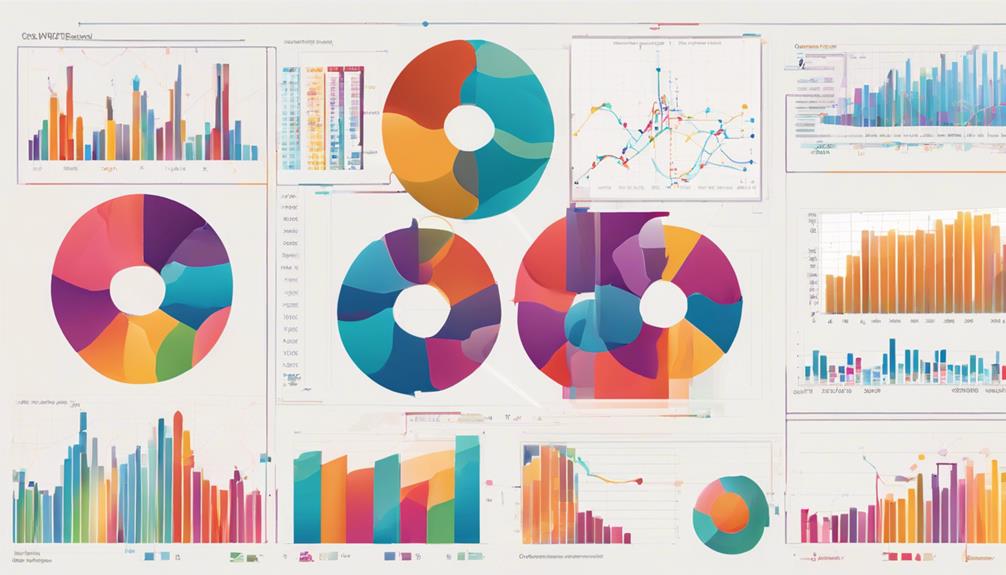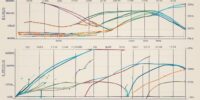Discovering Statistics Using IBM SPSS Statistics by Andy Field – Summary and Review

'Discovering Statistics Using IBM SPSS Statistics by Andy Field provides a comprehensive guide to mastering data analysis with SPSS, making statistical concepts easy to understand.
It is a valuable resource for both students and professionals looking to enhance their statistical skills.'
Key Takeaways
- Comprehensive guide for mastering data analysis with SPSS at all levels.
- Integration of statistical software into interactive teaching methods.
- Demystification of complex statistical concepts with practical examples.
- Enhancing analytical skills and decision-making acumen for practical applications.
Key Features of the Book
Within the pages of this illuminating book, readers will encounter a thorough exploration of the key features that make 'Discovering Statistics Using IBM SPSS Statistics' a valuable resource for both novices and experienced users alike. Andy Field seamlessly integrates statistical software, specifically IBM SPSS Statistics, into the world of data analysis, providing a detailed guide for users at all levels.
The book explores the intricacies of maneuvering this powerful tool, offering insights into conducting various statistical analyses with ease and precision.
One of the standout features of this book is its adept handling of complex statistical procedures within the user-friendly interface of IBM SPSS Statistics. Field's clear explanations and practical examples empower readers to harness the full potential of the software for insightful data analysis.
Engaging Teaching Style
With a focus on interactive teaching methods, the book's engaging teaching style captivates readers and enhances their learning experience.
Through a blend of humor and clear, concise explanations, the author succeeds in making complex statistical concepts more approachable and enjoyable.
This dynamic approach not only educates but also entertains, fostering a deeper understanding of the material.
Interactive Teaching Methods
Engage students effectively by incorporating interactive teaching methods that foster a dynamic and participatory learning environment. Active learning encourages students to participate actively in the learning process, promoting better retention and understanding. Technology integration allows for the use of various tools like educational apps, online resources, and interactive simulations to enhance the learning experience. By combining active learning strategies with technology integration, educators can create a more engaging and effective teaching environment. This approach not only caters to different learning styles but also keeps students motivated and invested in their learning journey. Embracing interactive teaching methods empowers students to take charge of their education, fostering a sense of autonomy and curiosity.
| Interactive Teaching Methods | Benefits |
|---|---|
| Active Learning | Encourages participation |
| Technology Integration | Enhances learning experience |
Humorous and Engaging
Embracing a humorous and engaging teaching style captivates students' attention and infuses a sense of enjoyment into the learning process. Statistical learning can be made more digestible and fun through the clever use of engaging humor.
Here are five ways to incorporate engaging humor into statistical learning:
- Jokes and Anecdotes: Sprinkle in relevant jokes and amusing anecdotes to lighten the mood.
- Puns and Wordplay: Use puns and wordplay to make complex concepts more memorable.
- Visual Humor: Incorporate humorous visuals or memes to reinforce key points.
- Interactive Activities: Engage students with interactive activities that have a humorous twist.
- Role-Playing: Encourage role-playing scenarios related to statistical concepts for a fun and immersive learning experience.
Clear and Concise
A teaching style that's both clear and concise enhances student understanding and retention of statistical concepts. By presenting complex ideas in a straightforward manner, instructors can demystify data analysis and make it more important to learners.
Practical examples play a significant role in illustrating how statistical techniques can be applied in real-world scenarios, allowing students to grasp the relevance and significance of the methods being taught. Through clear explanations and concise demonstrations, educators can break down intricate statistical procedures into manageable steps, fostering a deeper comprehension of the subject matter.
This engaging teaching style not only simplifies the learning process but also empowers students to confidently navigate the world of data analysis with clarity and precision.
Practical Application of Statistics
Embarking on the practical application of statistics involves engaging with real-world data sets and utilizing statistical tools to draw meaningful insights.
The decision-making process in statistics is a pivotal aspect, guiding researchers and analysts in making informed choices based on data-driven evidence.
Real-World Statistical Analysis
In the domain of statistical analysis, practical application is the cornerstone of turning data into meaningful insights and actionable decisions. Embracing real-world examples and seamless statistical software integration is key to unlocking the full potential of data analysis.
Here are five essential elements to ponder:
- Contextual Relevance: Ensuring statistical methods align with the specific real-world problem.
- Data Quality Assurance: Rigorous checks to maintain data accuracy and reliability.
- Interpretation Precision: Extracting clear and concise interpretations from complex statistical outputs.
- Actionable Recommendations: Transforming statistical findings into practical strategies.
- Continuous Learning and Adaptation: Embracing a dynamic approach to statistical analysis for evolving real-world scenarios.
Statistical Decision-Making Process
Browsing the statistical decision-making process requires a blend of analytical acumen and practical wisdom. Statistical inference and decision making are at the core of this process, guiding individuals through data analysis and hypothesis testing. By understanding statistical concepts and methodologies, one can make informed decisions based on evidence rather than intuition alone. To illustrate this further, consider the following table:
| Statistical Inference | Decision Making |
|---|---|
| Draws conclusions about populations based on sample data | Involves choosing between possible courses of action |
| Utilizes probability theory and sampling techniques | Considers risks, benefits, and uncertainties |
| Helps in generalizing results beyond the data at hand | Aids in selecting the most suitable option |
| Key in research and scientific investigations | Essential for problem-solving and strategy development |
| Forms the basis of many statistical tests and analyses | Influences outcomes and organizational success |
In mastering the statistical decision-making process, individuals empower themselves to navigate complex scenarios with clarity and precision.
Understanding Statistical Concepts
Delving into statistical concepts reveals the fundamental principles underlying data analysis and interpretation. Statistical reasoning involves more than just numbers; it requires a deep understanding of the logic behind the calculations and conclusions drawn from data analysis.
Here are five key points to ponder:
- Statistical Significance: Understanding the difference between results that are truly significant and those that occur by chance is essential in drawing valid conclusions.
- Descriptive Statistics: These provide a summary of the data's key characteristics, offering insights into the central tendency and variability of the variables under study.
- Inferential Statistics: Using sample data to make inferences about a larger population, this concept helps generalize findings beyond the immediate data set.
- Hypothesis Testing: A structured way to test claims or assumptions about a population parameter based on sample data, helping researchers make informed decisions.
- Probability: Fundamental in statistical analysis, it quantifies uncertainty and enables predictions based on the likelihood of different outcomes.
Mastering Statistics With SPSS
Mastering the art of statistical analysis with IBM SPSS Statistics enhances researchers' ability to extract meaningful insights from data with precision and efficiency. This statistical software empowers users to explore a variety of data analysis techniques, enabling them to uncover patterns, trends, and relationships that might otherwise remain hidden. By harnessing the capabilities of IBM SPSS Statistics, researchers can navigate through complex datasets with ease, conduct advanced statistical analyses, and generate informative visualizations that facilitate a deeper understanding of their data.
| Advantages of Mastering Statistics With SPSS | Benefits |
|---|---|
| User-friendly interface | Streamlined analysis processes |
| Wide range of statistical tests | Thorough data exploration |
| Customizable output options | Enhanced data visualization |
| Integration with other software tools | Seamless workflow integration |
| Robust technical support | Efficient problem-solving |
Comprehensive Statistical Journey
Starting on a thorough statistical journey reveals the intricacies of data analysis, offering a transformative perspective on interpreting information with depth and insight. Venturing on this extensive overview of statistical exploration can be a truly enlightening experience.
Here are five key aspects that make this journey worthwhile:
- Disclosing the beauty of patterns hidden within data.
- Empowering individuals to make informed decisions based on evidence.
- Providing a lens to understand the world through a quantitative framework.
- Cultivating a mindset that values critical thinking and analytical reasoning.
- Fostering a sense of curiosity and wonder about the mysteries of data.
Delving into the depths of statistical exploration not only equips individuals with valuable skills but also opens doors to a domain where numbers speak volumes. It's a journey that invites one to unravel the secrets of information, transforming raw data into meaningful insights that can shape perceptions and drive impactful decisions.
Benefit for Students and Professionals
Embarking on a journey into statistical exploration provides students and professionals with invaluable insights and practical skills that can greatly enhance their analytical capabilities and decision-making acumen. Through practical examples and real-world applications, individuals can grasp the core of statistical analysis and its significance in various fields. This learning experience empowers them to navigate through complex data sets, derive meaningful conclusions, and make informed decisions based on evidence rather than intuition.
For students, immersing themselves in statistical techniques provides a solid foundation for future academic pursuits and research endeavors. They learn to interpret data, test hypotheses, and communicate findings effectively. Professionals, on the other hand, benefit from honing their data analysis skills, enabling them to extract valuable insights that drive business strategies, optimize processes, and solve intricate problems.
Ultimately, the study of statistics using IBM SPSS Statistics equips individuals with a powerful toolset that goes beyond theoretical knowledge, offering practical wisdom that can be applied across diverse disciplines and industries.
Enhancing Skills With IBM SPSS
Enhancing one's analytical prowess and decision-making acumen is a transformative journey facilitated by the utilization of IBM SPSS Statistics. Mastering IBM SPSS skills opens doors to a world of statistical analysis possibilities, empowering individuals to extract valuable insights from data efficiently.
Here are five key ways to enhance your skills with IBM SPSS:
- Interactive Learning Resources: Engage with tutorials, online courses, and forums to deepen your understanding.
- Practical Application: Practice using real-world datasets to hone your analytical abilities.
- Customized Analysis: Learn to tailor analyses to specific research questions for more impactful results.
- Visualization Techniques: Explore data visualization tools within IBM SPSS to communicate findings effectively.
- Automation and Efficiency: Utilize features that automate repetitive tasks, saving time and improving productivity.
Frequently Asked Questions
Can This Book Be Used as a Standalone Resource for Learning Statistics, or Should It Be Used in Conjunction With Other Resources?
As a standalone resource, this book offers a thorough understanding of statistics. However, for a deeper grasp, supplementary materials can enhance the learning experience. Combining both elements guarantees a well-rounded statistical education.
Are There Any Specific Prerequisites or Background Knowledge Required to Effectively Use This Book?
Prerequisite knowledge to effectively use this book includes a basic understanding of statistics. No specific background requirements are essential, making it accessible for learners of varying levels. Its user-friendly approach fosters independent study.
How Does This Book Address Common Challenges or Misconceptions Students May Have About Statistics?
Addressing misconceptions and common challenges, this book clarifies statistical concepts with engaging examples and practical applications. It helps students navigate complex ideas with clarity, fostering a deeper understanding of statistics.
Does This Book Provide Guidance on Choosing the Appropriate Statistical Tests for Different Research Questions or Scenarios?
Yes, the book provides clear guidance on choosing the appropriate statistical tests based on research design and specific research questions. It simplifies hypothesis testing and data interpretation, making statistical analysis more accessible and understandable for readers.
Are There Any Hands-On Exercises or Practical Examples Included in the Book to Help Reinforce Learning and Understanding of Statistical Concepts?
The book features hands-on exercises and practical examples that engage readers, reinforcing statistical concepts effectively. These interactive elements provide a dynamic learning experience, enhancing understanding and application of statistical methods in a meaningful way.











